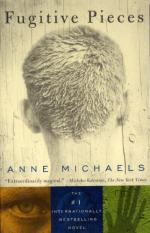
|
| Name: _________________________ | Period: ___________________ |
This test consists of 5 short answer questions, 10 short essay questions, and 1 (of 3) essay topics.
Short Answer Questions
1. When does Jakob finish writing his life's stories?
2. What does Ben's father forbid anyone mentioning?
3. Upon what does Jakob sometimes lecture?
4. How does Jakob make a living?
5. What is Zakynthos like?
Short Essay Questions
1. How does Ben's father escape a Nazi camp?
2. Describe Jakob's visions of prisoners going to the gas chamber.
3. What theme does Ben incorporate into his thesis?
4. What is Jakob's work in Greece?
5. How does Ben find Jakob's study?
6. What is the significance of the color yellow?
7. Describe Ben's futile search for Jakob's journals.
8. How does Jakob relate a theory by Einstein to the Holocaust?
9. How are Jakob's initial days in Greece?
10. What does Michaela say about her parents and the pioneer museum?
Essay Topics
Write an essay for ONE of the following topics:
Essay Topic 1
Jakob emphasizes that he does not see the horrors that visit European Jewry during World War II while he is living in Greece. He endures hardships on Zakynthos and lives in constant fear of the door being bashed in, as had happened in his home in Poland. All of Zakynthos's Jews are saved from the Nazis through the courage of the Christian mayor and archbishop. By comparison, most of the Jews on nearby Corfu perish by drowning or in concentration camps.
1. Discuss what affect the constant fear with which Jakob lives would have on a young boy. Use examples from your own life and "Fugitive Pieces" to support your answer.
2. Discuss reasons you think some people like the mayor and Bishop tried to help the Jewish people and others did not. Use examples from your own life and "Fugitive Pieces" to support your answer.
3. Discuss, in depth, the concept of courage as it relates to the mayor and the archbishop. Use examples from your own life and "Fugitive Pieces" to support your answer.
Essay Topic 2
Discuss one of the following:
1. Thoroughly analyze how the setting informs the plot in "Fugitive Pieces".
2. Trace and analyze one major theme of the book. How is the theme represented by symbolism? By the characters' behaviors? By the action?
3. Trace and analyze two secondary themes of "Fugitive Pieces". How are the themes represented by symbolism? By the characters' behaviors? By the action?
Essay Topic 3
Choose one of the following to discuss:
1. Choose two significant symbols and trace and analyze their appearance in "Fugitive Pieces". Are these universal symbols? Would they be understood in any culture? Are there other symbols that would portray the same idea? What are they? Why do you think Michaels chooses the symbols she does?
2. Choose two important metaphors and trace and analyze their appearance in the novel. Are these universal metaphors? Would they be understood in any culture? Are there other metaphors that would portray the same idea? What are they? Why do you think Michaels chooses the metaphors she does?
3. Discuss Michaels's use (or lack ) of literary device (such as foreshadowing, cliffhangers, deux ex machina, etc.), and how they add or detract from the story. Does Michaels use too many or too little literary techniques? State which of the five major elements of fiction the literary device is related to (style, character, plot, setting, theme).
|
This section contains 968 words (approx. 4 pages at 300 words per page) |

|




